Digital infrastructure is expected to run at near-zero latency, adapt instantly to shifting workloads, and remain secure under relentless pressure. Yet, networks, the nervous system of modern enterprise, still struggle with outages, configuration drift, and inefficiencies that cause costly downtime. The next frontier in solving this challenge? Self-healing networks powered by AI.
At the core of this evolution is the ability to automate not just operations, but intelligence. Self-healing systems monitor themselves, learn from past incidents, and trigger corrective actions without human intervention. In other words, they don’t just notify, they act.
This isn’t a futuristic ideal. Engineers like Abhishek Gupta, a Cisco engineering technical leader, and a IEEE SoutheastCon 2025 paper reviewer, they are already putting these principles into practice. With a decade-long career in network analytics, and automation-first design, Gupta represents the new breed of infrastructure architects focused on intelligence at scale.
The Shift from Reactive to Autonomous Resilience
Traditional networks are reactive, logs are pulled, root causes traced, and fixes manually applied, often too late. Gupta’s work flips that paradigm. During his tenure as the lead engineer on Cisco DNA Center Assurance, Gupta helped design a real-time analytics platform capable of transforming how hospitals, financial institutions, and government agencies manage mission-critical networks.
The system collected live telemetry from endpoints and devices, analyzed anomalies using real time streaming pipelines, and delivered health scores and corrective actions with minimal delay. In environments like hospitals and defense networks, where network outages risk lives or national security, this capability reduced troubleshooting time by more than 50% and achieved up to 86% reduction in unplanned downtime.
His efforts led to the platform’s adoption by over 12,000 customers, including the federal government establishments, universities, retail, hospitals etc. His influence extended beyond backend engineering; Gupta spearheaded a redesigned navigation system and Catalyst Center Global Manager, ensuring better UX and improved customer satisfaction across Cisco’s enterprise tools.
AI-Powered Recovery in Action
In his scholarly paper, Leveraging Large Language Models for Log Mining: A New Paradigm in Data Analysis, Gupta lays out a vision for how networks can leverage generative models for health simulation and self-repair. The rise of large language models (LLMs) presents a novel opportunity for log mining, given their ability to understand unstructured text and learn from contextual patterns without extensive pre-processing. This paper explores the potential of LLMs for log mining, discusses challenges, and proposes a framework for their effective application.
These methods elevate the idea of machine-led troubleshooting, from identifying anomalies from logs is a crucial task in IT operations, security, and software development for identifying anomalies, patterns, and trends in system logs. Traditional methods for log analysis rely heavily on rule-based approaches or machine learning models that require significant feature engineering.
As Gupta noted in this article “Performance Under Pressure: Ensuring Data Continuity & Reliability with Abhishek Gupta” – modern infrastructure can no longer afford to fail silently. “Today’s systems need to offer not just reliability, but continuity, especially under pressure,” he said. “It’s about designing for recovery, not just uptime.”
These innovations eliminate the need for human-driven triage by embedding intelligence directly into infrastructure, networks that adapt in real time, correct misconfigurations, and optimize performance autonomously.
The Future Is Self-Healing
As networks span hybrid clouds, edge environments, and globally distributed users, the demand for adaptive, resilient infrastructure has never been greater. Tools like Cisco DNA Center Assurance are no longer just dashboards, they’re AI-powered command centers that prevent issues before they spiral into crises.
Abhishek Gupta’s thought leadership also extends into writing. As a published author on DZone, he explores how observability, machine learning, and distributed systems design must converge to support real-time, scalable operations. His articles unpack the role of AI in detecting drift, responding to anomalies, and safeguarding systems under unpredictable load, insights that stem from real-world deployments, not theory. The future of infrastructure isn’t just smarter. It’s self-healing, adaptive, and ready for whatever comes next.



